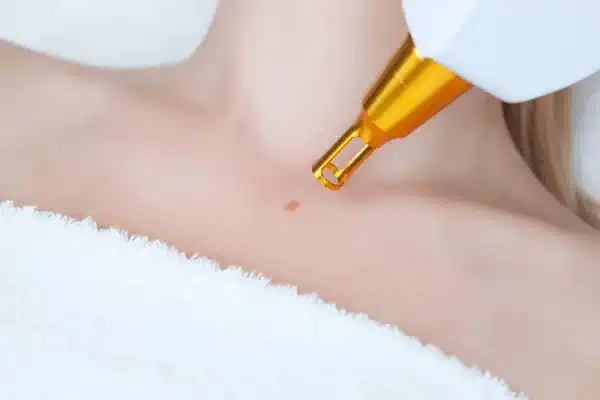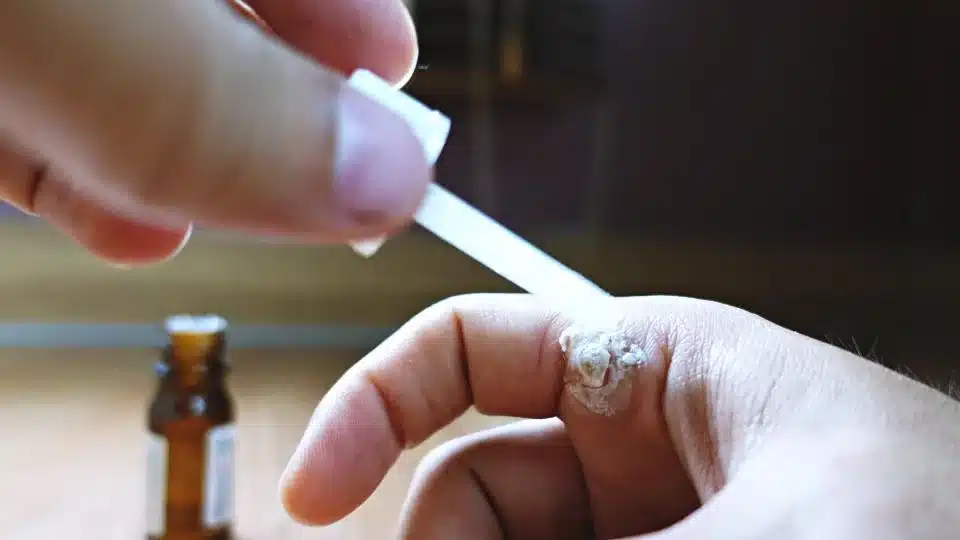Red moles or angiomas are common benign skin growths that can appear as red, purple or blue spots on various parts of the body. They are also known as Campbell de Morgan spots, cherry angiomas, or senile angiomas. Typically, they are harmless and are made up of small blood vessels that may resemble moles.
The exact cause of red moles is still unknown, but several factors may contribute to their development, including:
While angiomas or red moles are usually harmless, they can cause discomfort, such as itching, pain, or infection. Additionally, some individuals may want to remove angiomas for cosmetic reasons, especially if they are located in visible areas such as the face, neck, or chest. Others may find them bothersome or embarrassing, which could affect their self-esteem and confidence.
Common reasons why people in Singapore may want to remove cherry angiomas include:
Proper angioma / red mole removal by a medical professional is essential.


Vascular lasers, such as pulsed dye, gold, long-pulsed NdYAG, or KTP lasers, can be used to remove cherry angiomas by targeting the blood vessels that make up the red mole. The laser emits a specific wavelength of light that is absorbed by the blood in the vessels. The long pulse duration produces a photothermal effect causing the blood to heat up and coagulate. This causes damage to the walls of the blood vessels which are then naturally eliminated by the body.
Examples of such lasers include:
Generally, as the laser wavelength increases. absorption in haemoglobin and melanin decreases. The degree of scattering in the skin also decreases hence longer wavelength lasers would be able to penetrate deeper. The most suitable vascular laser would depend on the characteristics of your skin and the targeted blood vessels.
Laser therapy is often used for larger angiomas and can take multiple treatment sessions to achieve the desired results. Vascular lasers have a relatively low risk of scarring as they are very selectively absorbed and thus cause less collateral damage to the skin. Hence, they are popular amongst patients looking for 'scarless' angioma or red mole removal.

High-frequency radiofrequency is strongly absorbed by water in cells causing vaporization or coagulation depending on the waveform. As the radiofrequency energy passes through the blood vessels in the red mole or angioma, it damages them causing them to close up. The damaged vessels are then removed by the body. Radiofrequency is fast and effective for removing small cherry angiomas. However, it is not as selective as laser removal and tends to cause relatively more collateral damage. Thus there is more likelihood that there may be some scarring or discolouration in the treated area, compared to laser.
Intense Pulsed Light can be used with vascular filters to selectively target haemoglobin in the blood similarly to vascular lasers. They can be used to treat red moles or angiomas. However, even medical-grade IPLs cannot produce power comparable to vascular lasers and are generally regarded as less effective for vascular lesions.
Normal IPLs without vascular-specific filters (common in spas) are even less safe and effective.

Cryotherapy involves using liquid nitrogen to freeze and destroy the blood vessels in the angioma, causing them to break down and be absorbed by the body. It can be used for small angiomas however it is much less precise than laser or radiofrequency, increasing the chance of complications such as scarring or hypopigmentation (white spots).
Topical medications, such as immune response modulators or beta blockers, can be used to treat small, superficial angiomas. These medications work by causing the blood vessels in the angioma to shrink, which reduces its size and appearance.
Immune system modulators stimulate the immune system to attack abnormal skin cells, including the blood vessels in the angioma. Beta-blockers work by reducing the activity of the blood vessels in the angioma, causing them to shrink and reducing the size and appearance of the angioma.
Topical medications are generally considered safe and non-invasive treatment options for small, superficial angiomas. However, they take much longer to achieve results compared to other more directed treatments such as laser therapy or electrocautery. Additionally, they may not be effective, especially for larger or deeper angiomas.
.

Excision involves surgically removing the angioma. This treatment option may be considered for larger, deeper or more complicated angiomas and may require a longer recovery period. It always results in a surgical scar.
Red moles or angiomas are often confused with moles. While both of these skin growths can be bothersome to patients, treatments for red moles or angiomas are distinctively different from mole removal methods.
Topical red mole removal creams can treat small and flat angiomas well. However, they are relatively costly and not widely available in Singapore. Hence if you only had one or two angiomas, it may be better to just see a qualified doctor for the removal of these growths.
Surgical excision is rarely indicated for uncomplicated angiomas, as it results in scarring. Intense pulsed light devices and cryotherapy are relatively crude methods compared to the more advanced methods that are the standard of care now.
Radiofrequency and vascular laser are the two mainstays of red mole or angioma removal at the moment, and they each have their advantages.
Radiofrequency tends to be faster and simpler to perform and is better able to treat angiomas that are thicker or extend deeper. However, it has a higher risk of scarring as there is more collateral damage to the surrounding skin tissue
Vascular lasers have a relatively low scarring risk due to their selectivity but their limited penetration may necessitate multiple treatment sessions, especially for large, raised or deep angiomas. We have a range of vascular lasers with different wavelengths and characteristics to cater to different skin types and to treat different sizes and depths of angiomas.
For most uncomplicated cases, laser angioma or red mole removal would be the most suitable option. However, in more complicated cases, it may be necessary to combine the advantages of different techniques to achieve the best possible result.
Angioma removal costs in Singapore can range widely from less than $100 to more than a thousand dollars. The price of red mole removal depends strongly on the chosen medical aesthetic technique, the number of lesions treated, and the complexity of the removal.
It is common for patients to try to get their angiomas or red moles removed at beauty salons. Many times, the beautician may know even know what an angioma is and how it is different from a mole. They may attempt removal using crude mole removal methods that cause unnecessary damage and expose patients to unnecessary risk of scarring. The scarring that develops may actually look worse than the cherry angioma and cost more to treat.

FOUNDER / MEDICAL DIRECTOR
Address:
1Aesthetics, Medical & Surgery
#14-90 The Central Tower 1
8 Eu Tong Sen Street
Singapore 059818
Mon-Fri 9 AM to 7 PM
Sat 9 AM to 3 PM
Phone / WhatsApp:
+65 66125173 / +65 84899962
Email:
[email protected]